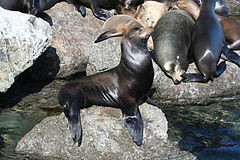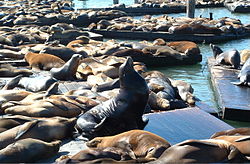Sea lion
| Sea Lion | |
|---|---|

| |
| A sea lion in Monterey, California | |
| Scientific classification | |
| Kingdom: | |
| Phylum: | |
| Class: | |
| Order: | |
| Suborder: | |
| Family: | |
| Subfamily: | Otariinae
|
| Genera | |



A sea lion is one of many marine mammals of the family Otariidae. Sea lions are characterized by the presence of external ear pinnae or flaps, long front flippers, and the ability to walk on four flippers on land. They are generally found in shallow waters of coastal areas of both northern and southern hemispheres, with abundant food sources.[1]
Sea lions of many species have seen a severe and rapid decrease in numbers in recent years. Many factors including overfishing of prey species, shooting by fishermen and pollution have probably contributed to the decline. The population of Steller sea lions in Alaska has declined as much as 80% since the 1970s. [2] [3] In contrast, California sea lions are abundant and the population continues to expand at a rate of approximately 5.0% annually, as it has since the mid-1970s.[4]
Sea lions are often a popular attraction at zoos and aquariums, performing behaviors such as throwing and catching balls on their noses and clapping.
Hybrids
A hybrid sea lion from a cross between the California sea lion (Zalophus californianus) and the South American sea lion (Otaria byronia) has occurred.
Sea lions and humans

The government of Japan has set a quota of 116 kills per year in Hokkaido,[citation needed] as sea lions are seen as a threat to commercial fisheries. International environmentalists and local fishery advocates continue to debate the issue.
The Norwegian government has set a quota of 200 kills per year.[citation needed]
Sea lions have been trained by the U.S. Navy's Marine Mammal Program, based in San Diego to detain scuba divers. [5]
Sea lion attacks on humans are rare, but have occurred in at least a single notable case, in which a 13 year-old Australian girl was attacked while in the water. Sources said that the likeliest explanation was that the animal was attempting to play with the girl.[6][7][8]
The Moche people of ancient Peru worshipped the sea and its animals. They often depicted sea lions in their art. [9]
References
- ^ "ANIMAL BYTES - Sea Lions & Fur Seals". Retrieved 2007-07-21.
- ^ Clover, Charles. 2004. The End of the Line: How overfishing is changing the world and what we eat. Ebury Press, London. ISBN 0-09-189780-7
- ^ Dalton, Rex. 2005. "Is this any way to save a species?." Nature 436, 7 July 2005, 14-16.
- ^ Lowry, Mark S. and Karin A. Forney, Abundance and distribution of California sea lions (Zalophus californianus) in central and northern California during 1998 and summer 1999. Fishery Bulletin, Vol. 103, no. 2, pp. 331-343.
- ^ Watkins, Thomas (2007-02-12). "Navy may deploy anti-terrorism dolphins". Associated Press. Retrieved 2007-02-12.
- ^ BBC News: Sea lion attacks Australian girl
- ^ news.com.au: Monster sea lion likely to be 'playing' with teen
- ^ Sea lion mauls girl
- ^ Berrin, Katherine & Larco Museum. The Spirit of Ancient Peru:Treasures from the Museo Arqueológico Rafael Larco Herrera. New York: Thames and Hudson, 1997.
